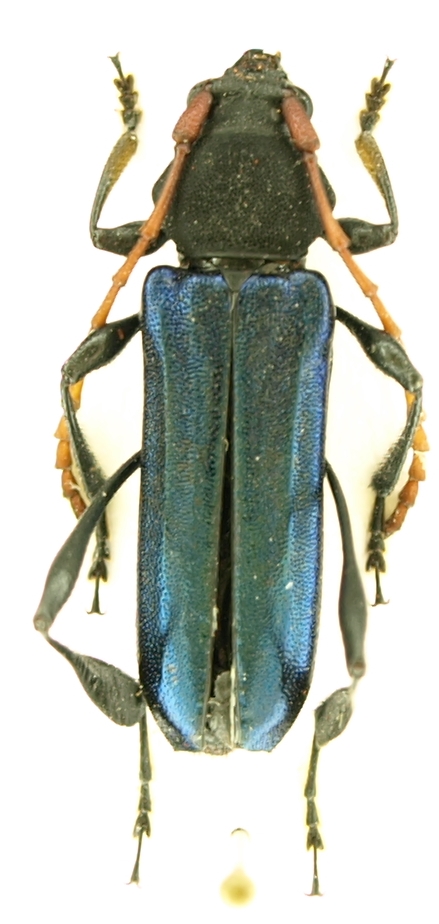| Author |
 Topic Topic  |
|
|
Vitali
Member Rosalia
  
Estonia
995 Posts |
 Posted - 21/01/2014 : 14:45:30 Posted - 21/01/2014 : 14:45:30



|

213.57 KB
I have a series of beetles which I identify with the aid of Schmidt, 1922 as Helymaeus sp, but I am not able to reach further. Maybe someone who has Revision du Genre Helymaeus Thomson, 1864 et Genres Voisins by Pierre Juhel and Joan Bentanachs can help me.
The Schmidt's tables divide Helymaeus generally in two groups: first with yellow legs and abdomen and matt pronotum, second with mostly black legs and shiny pronotum. My beetles have black legs and pronotum absolutely matt because of strong microsculpture.
Only antennae are reddish yellow to brown.
The pronotum is angulated at sides with practically no white pubescence, only two small white dots each on a side bump in some specimens.
Abdomen is metallic black with patches of white pubescence along the apical edge of the first sternite, interrupted in the middle.
Hind tibia flat, curved and broadened in the second half.
I made a photo of one specimen which unfortunately appeared a bit dirty. Sorry for that. |
|
|
Pierre
Member Rosenbergia
   
Switzerland
1755 Posts |
 Posted - 21/01/2014 : 18:41:24 Posted - 21/01/2014 : 18:41:24



|
This is not a Helymaeus but belongs to the closely related genus Phyllomaeus Schmidt, 1922. The enlarged metatibia remember some small Phyllocnema.
Tis specimen fits perfectly with Phyllomaeus nigricollis Kolbe, 1897, reported from Kenya. The ssp. tibialis Schmidt, 1922 is cited from Tanzania and should have a some reddish mark on the hind tibia (I can not see this detail ou your photo), but African Callichromatini vary a lot and this ssp. could be a simple chromatic variant of nigricollis...
A very interesting and uncommon species! |
 |
|
|
Vitali
Member Rosalia
  
Estonia
995 Posts |
 Posted - 21/01/2014 : 19:51:25 Posted - 21/01/2014 : 19:51:25



|
Dear Pierre, thank you a lot!
You may be right. Phyllomaeus should differ from Helymaeus by pubescent pronotum. The trouble is that this pubescence is so fine that I could not see it even with a microscope and missed this branching of the key. The pronotum is matt seemingly because of microsculpture. Besides, I don't see black pubescence in elytra (maybe for the same reason), no three black bands in elytra. Other characters correspond to P. nigricollis, although I would not call antennae "kastanienbraun". These are yellow-brown or red-brown, but this is hardly ssp tibialis Schmidt, 1922. The tip of metatibia is not red, sometimes reddish hue is in the beginning of the tibia expansion.
Do you know by any chance P. gloriosus (Péringuey, 1899)?
|
 |
|
|
Pierre
Member Rosenbergia
   
Switzerland
1755 Posts |
 Posted - 21/01/2014 : 20:28:08 Posted - 21/01/2014 : 20:28:08



|
Vitali, Schmidt in his descriptions insists on this dense pubescense on head and pronotum. Nevertheless neither Pierre Juhel in his studies nor I could ever see such kind of tomentum; the specimen show dull, mat surfaces such as you observe.
The colour of the antennae of your specimen is testaceous or reddish, exactly as described in Schmidt's ssp.
I have P. gloriosus in my collection. It is close to nigricollis but differs from this taxon by partly red legs. |
 |
|
|
Vitali
Member Rosalia
  
Estonia
995 Posts |
 Posted - 21/01/2014 : 20:47:50 Posted - 21/01/2014 : 20:47:50



|
OK, then this is Phyllomaeus nigricollis (Kolbe, 1897). I have a large series, the colour of antennae varies from yellow to brown, legs are almost always black, except a few specimens with a reddish hue in the middle of tibia.
Thank you once more. |
 |
|
|
Pierre
Member Rosenbergia
   
Switzerland
1755 Posts |
 Posted - 05/02/2014 : 18:22:21 Posted - 05/02/2014 : 18:22:21



|

252.91 KB
Vitali, see P. gloriosus; impossible to confuse.
Tanzania, Rungwe hills. |
 |
|
|
Vitali
Member Rosalia
  
Estonia
995 Posts |
 Posted - 06/02/2014 : 09:39:17 Posted - 06/02/2014 : 09:39:17



|
| Yes, indeed. And a beautiful species! |
 |
|
| |
 Topic Topic  |
|


